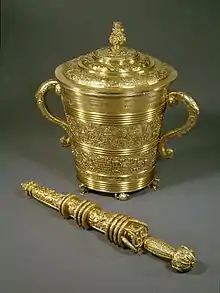Rose Flower Cup
The Rose Flower Cup (Danish: Rosenblommen) is a large silver-gilt communal drinking vessel, with two handles and a detached lid, holding six litres and weighting almost 6 kilograms (13 lb), presented to the later King Christian IV of Denmark at his christening in 1577 by his godfather Hans Skovgaard and his wife Anne Parsberg. The name refers to a verse inscribed on the exterior of the vessel. It is now in the collection of the National Museum of Denmark.
| Rose Flower Cup | |
|---|---|
 | |
| Material | Silver |
| Created | 1577 |
| Present location | National Museum of Denmark |
History
.jpg.webp)
Hans Skovgaard (1526–1580), one of King Frederick II's favourites, served as secretary of the Danish Chancellery and was generously rewarded with royal fiefs.[1] In 1573, one year before marrying Anne Parsberg (1549–1582), against the wishes of the king, he retired from the royal court to his estate Gunderstrup in Scania. Frederick II nonetheless hosted his wedding at Copenhagen Castle and as a wedding present gave him a richly decorated silver tankard.[2]
When Frederik II and Queen Sophie of Mecklenburg-Güstrow had their first son, Christian (1577–1648), who would later succeed his father as Christian IV in 1588, Skovgaard was one of the prince's godfathers. At the christening, he and his wife presented the Queen, on the prince's behalf, with the large Rose Flower Cup. It is the only remaining gift of the godfathers.[3]
It is unclear who made the vessel. Bearing the maker's mark AE conjoined, it is however, somewhat cautiously, attributed to Royal Goldsmith and armour maker (Plattenschlager) Aelisaeus Englander.[2]
Design
.JPG.webp)
The Rose Flower Cup, which holds six litres (eight pots) and has a weight of almost six kilos, is designed in the form of a generous barrel with two handles. Compared to normal tankards, its second handle was a necessity due to its massive size. As is the case with so-called peg tankards, it is fitted on the inside with pegs at regular intervals to mark the quantity each person is supposed to drink. The exterior is decorated with hunting scenes, probably as a reference to Frederick III, who was an enthusiastic huntsman. Hans and Anne Skovgaard's coat of arms is also part of the decoration. A red and white rose has been interpreted as representing the union of the sun and the moon giving birth to the Filius philosophorum.[2] A medallion on the interior of the cover, depicting David playing before King Saul, is most likely a reference to the recipient (Frederik) and the giver (Skovgaard).[2] The exterior is also inscribed with the year 1577 as well as a verse:[3]
Mit Navn det kaldes en "Rosenblomme".
Billigt bør man favne mit Komme.
Gæsterne vil jeg med Kunsterne min'
– Naar udi mig skænkes den klare Vin –
Trolign tilhjælpe Sorgen fordrive,
Saa de alle skulle glade blive.
Thi tag mig op og drik paa Love!
Det er den ret gamle Vis til Hove.
See also
References
- "Hans Skovgaard" (in Danish). Dansk Biografisk Leksikon. Retrieved 12 June 2021.
- "A silver-gilt cup and cover, maker's mark AE conjoined, probably Copenhagen, circa 1574". alaintruong.com. Retrieved 14 October 2021.
- Troels-Lund, Tr. Fr. "Dagligt Liv i Norden i det sekstende Aarhundrede: Drikkelag" (in Danish). Retrieved 12 June 2021.
Further reading
- Grinder-Hansen, Poul: Aspects of gift giving in Denmark in the sixteenth century and the case of the Rose Flower Cup. Journal of Medieval History, 2011, 37:1, 114-124
- Schoubye, Sigurd: Renæssanceguldsmeden AE, in Kunst og antikvitets årbogen, Thaning & Appels Forlag, Copenhagen, 1970, pp. 89-103
- Grinder-Hansen, Poul: Rosenblommen: en gave, der var en kongesøn værdig, in Nationalmuseets Arbejdsmark Copenhagen, pp. 100-116